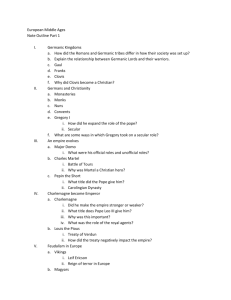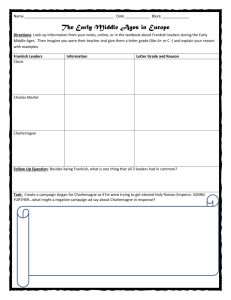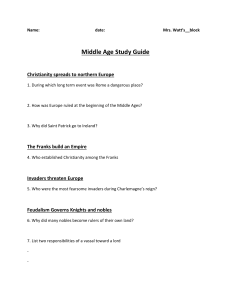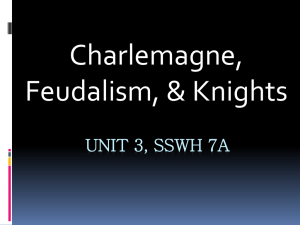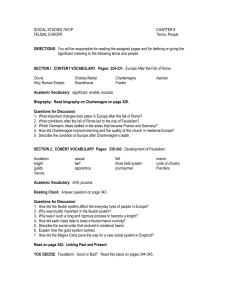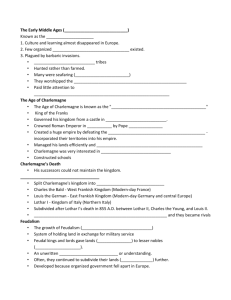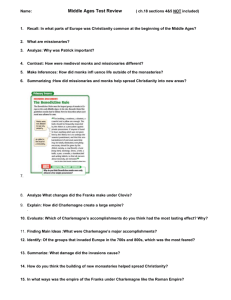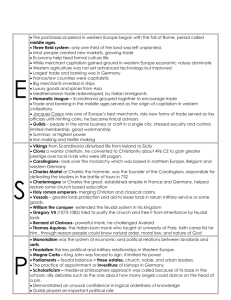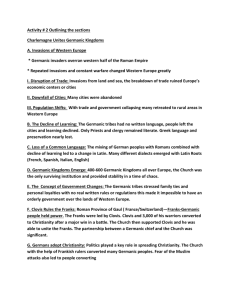Feudal Europe - Locke Middle School, 8A Social Studies, Mr. Doneski
advertisement
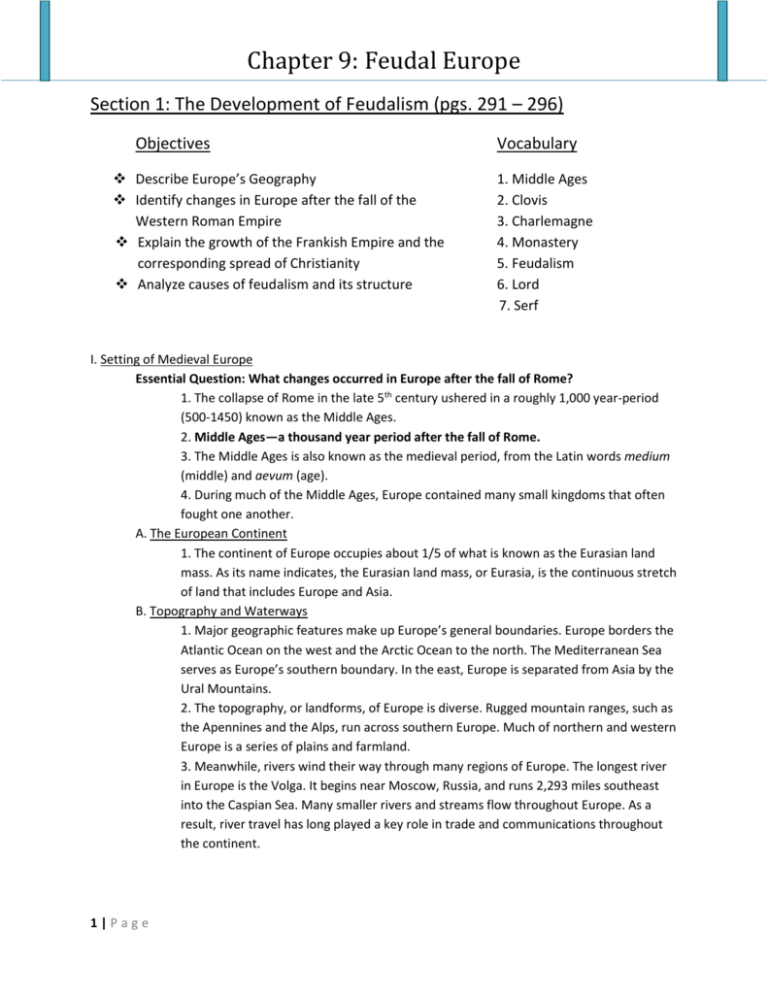
Chapter 9: Feudal Europe Section 1: The Development of Feudalism (pgs. 291 – 296) Objectives Describe Europe’s Geography Identify changes in Europe after the fall of the Western Roman Empire Explain the growth of the Frankish Empire and the corresponding spread of Christianity Analyze causes of feudalism and its structure Vocabulary 1. Middle Ages 2. Clovis 3. Charlemagne 4. Monastery 5. Feudalism 6. Lord 7. Serf I. Setting of Medieval Europe Essential Question: What changes occurred in Europe after the fall of Rome? 1. The collapse of Rome in the late 5th century ushered in a roughly 1,000 year-period (500-1450) known as the Middle Ages. 2. Middle Ages—a thousand year period after the fall of Rome. 3. The Middle Ages is also known as the medieval period, from the Latin words medium (middle) and aevum (age). 4. During much of the Middle Ages, Europe contained many small kingdoms that often fought one another. A. The European Continent 1. The continent of Europe occupies about 1/5 of what is known as the Eurasian land mass. As its name indicates, the Eurasian land mass, or Eurasia, is the continuous stretch of land that includes Europe and Asia. B. Topography and Waterways 1. Major geographic features make up Europe’s general boundaries. Europe borders the Atlantic Ocean on the west and the Arctic Ocean to the north. The Mediterranean Sea serves as Europe’s southern boundary. In the east, Europe is separated from Asia by the Ural Mountains. 2. The topography, or landforms, of Europe is diverse. Rugged mountain ranges, such as the Apennines and the Alps, run across southern Europe. Much of northern and western Europe is a series of plains and farmland. 3. Meanwhile, rivers wind their way through many regions of Europe. The longest river in Europe is the Volga. It begins near Moscow, Russia, and runs 2,293 miles southeast into the Caspian Sea. Many smaller rivers and streams flow throughout Europe. As a result, river travel has long played a key role in trade and communications throughout the continent. 1|Page Chapter 9: Feudal Europe C. Climate and Vegetation 1. The climate patterns of Europe vary across the continent. Northern Europe experiences cold winters, while southern Europe has mild winters and hot and often dry summers. Most of Europe receives plenty of rainfall. As a result, there is much forest and farmland. 2. Generally mild weather and dependable rainfall have enabled agriculture to thrive throughout Europe. In the warmer weather of the Mediterranean region, for example, farmers of Medieval Europe could grow citrus fruits. Meanwhile, crops such as wheat and barley thrived in the climate of Western Europe. 3. The abundance of forests, farmland, and rivers played a key role in shaping ways of life in Medieval Europe. Europe became home to many small kingdoms and small estates that thrived on their own. This was due in large part to the favorable climate and topography which allowed people to take and produce much of what they needed from the land. D. Cultural Changes 1. The political and cultural landscape of Europe changed greatly after the fall of Rome. The Romans no longer ruled the region by unifying its many different groups under one government. Instead, numerous Germanic kingdoms dominated the lands that had once been ruled by a mighty empire. 2. The Germanic groups that occupied Europe after the fall of Rome brought great cultural changes to the continent. The Romans, as you recall, had a highly developed government. They believed that the state was more important than the individual. The Romans also emphasized learning. 3. The Germanic peoples, on the other hand, had little notion of a state. Unlike the Romans, Germanic people lived in small communities and maintained order through unwritten rules and traditions. As a result, they did not develop large governments or trade systems. In addition, they did not emphasize learning scholarly works. E. Learning and Trade Decline 1. The educated middle class all but had disappeared during the Middle Ages. Most schools ceased to exist. Eventually, few people could read or write Latin. Europeans mostly forgot about the great achievements of the ancient Greeks and Romans in the arts and learning. 2. As trade throughout Europe disappeared, so did many cities. Most city dwellers made their living by trading goods. The lack of trade prompted many of them to move to the country, where they made their living by farming. II. Christianity Grows and Spreads Essential Question: What factors helped Christianity to grow and spread? 1. One institution that survived the fall of Rome was the Christian Church. Many German rulers and their subjects converted to Christianity. These conversions helped to spread Christianity throughout Europe. 2. A group of Germanic people, the Franks, established one of the more powerful kingdoms in Europe during the Middle Ages. The Franks and their powerful leaders 2|Page Chapter 9: Feudal Europe played a significant role in strengthening Christianity north of the Alps in the lands of northern and western Europe. A. Clovis and the Franks 1. Clovis—a Frankish leader, in 486 he invaded Roman Gaul (France). He defeated the last great Roman army in Gaul. Clovis then went on to defeat other weaker Germanic groups. By 507, his kingdom stretched west from the Rhine River to the Pyrenees Mountains. 2. Around this time, Clovis converted to Christianity. In time, most of his subjects became Christians. B. The Rule of Charlemagne 1. Clovis died in 511. Some two centuries later, in the early 700s, a powerful leader named Charles Martel became ruler of the Franks. Charles expanded the Frankish kingdom through military conquest. Charles Martel’s son, Pepin the Short, became the next king of the Franks. Pepin ruled until his death in 768. His son Charles, also known as Charlemagne, then took over the kingdom. 2. Charlemagne—king of the Franks, ruled from 768 to 814. He expanded the Frankish kingdom into a Frankish Empire that incorporated much of Western and Central Europe. His rule is also associated with the Carolingian Renaissance, a revival of art, religion, and culture through the medium of the Catholic Church. In 800, Pope Leo III crowned Charlemagne the Holy Roman Emperor. 3. Charlemagne built a European empire greater than any known since Ancient Rome. By 800, the powerful Frankish king ruled much of Western Europe. Charlemagne created a highly organized and well-run empire. He established new laws to help keep order in the kingdom. In addition, he enlisted powerful landholders known as counts to govern the many different regions of the empire. Charlemagne often traveled throughout the kingdom to ensure that the counts ruled justly. 4. Under the leadership of Charlemagne, Christianity grew stronger across Europe. Charlemagne spread Christianity through his conquests. A deeply religious man, he also encouraged and sometimes forced his subjects to become Christians. C. The Growth of Monasteries 1. While powerful rulers helped to spread Christianity, devoted worshipers did the same. During the Middle Ages, religious structures known as monasteries arose across Europe. 2. Monastery—a place of prayer and worship. 3. Monasteries were places where religious followers called monks practiced a life of prayer and worship. In monasteries, monks studied Christian works and made copies of the Bible. By doing so, they preserved and promoted the ideas and beliefs of Christianity. 3|Page Chapter 9: Feudal Europe III. Feudalism: A New Social Order Essential Question: What was feudalism and how did it work? 1. After Charlemagne’s death in 814, his son, Louis I, became emperor. When Louis died, his three sons fought each other for control of the kingdom. They all signed a treaty in 843 that divided the empire into three parts. This split caused the Frankish kingdom to grow weak and unstable. The decline of Frankish rule led to disorder across Europe. 2. Various groups of people took advantage of this disorder. Scandinavian pirates, called Vikings, terrorized coastal villages. Muslims raided coastal areas in Italy and southern France. A group known as the Magyars attacked towns throughout central Europe. Beginning in the mid-800s, Europe became a place of constant conflict and warfare. A. The Emergence of Feudalism 1. The unstable and violent period led to the creation of a political and social system known as feudalism. 2. Feudalism—a political and social system based on agreements between lords and vassals. 3. Feudalism emerged largely as a way for kings and nobles to hold onto their land and power amid so much warfare. 4. Feudalism was based on an agreement between two groups of nobles—lords and vassals. 5. Lord—a powerful noble who owned land. 6. Lords gave pieces of their land to lesser nobles called vassals. These plots of land were called fiefs. In return for the land, the vassal owed his lord service in his court and army. Many vassals were warriors known as knights. Thus, they fought on behalf of the lord. Other vassals hired knights to defend the lord and his property. Vassals also paid taxes to their lord in return for their fief. B. The Feudal Structure 1. Feudal society was highly structured. The king ruled at the top of society. Next came wealthy landowners and high-ranking church members. Serving below them were the knights. At the bottom of society were the peasants. Most peasants were serfs. 2. Serfs—a peasant who lived and worked on land of a lord or vassal. In return, the nobles granted them shelter and protection. 3. Feudalism created a new political structure in Europe. Europe became home to many small kingdoms and estates ruled by kings and powerful nobles 4|Page Chapter 9: Feudal Europe FEUDALISM IN EUROPE DURING THE MIDDLE AGES KING this man sat atop feudal society and ruled over large areas of land Church Officials and Nobles these people owned land and thus held much power and wealth Vassals/Knights lesser nobles provided military service and a percentage of their crop production in return for land or a fief Peasants/Serfs peasants worked the land for nobles and performed other backbreaking tasks/serfs were tied to the land legally and not allowed to leave 5|Page Chapter 9: Feudal Europe 6|Page
